ENVIS Technical Report: 89, July 2015 |
 |
Biodiversity, Ecology, Energy, Landscape Dynamics & Hydrology of Agastya Foundation Campus, Kuppam
| 
|
| Ramachandra T. V.* |
Harish R.Bhat |
Bharath H. Aithal |
Rao G. R. |
Sudarshan P.Bhat |
| Vinay S. |
Ganesh Hegde |
Gouri Kulkarni |
Vishnu D. Mukri |
|
|
Kingdom |
Animalia |
Phylum |
Chordata |
Class |
Reptilia |
Sub-class |
- Snakes (Squamata)
- Lizards (Squamata)
- Crocodiles and Gharials (Crocodilia)
- Turtles, Terrapins and Tortoises (Testudines)
|
Reptiles are easily distinguishable as they
- lack hair on their body,
- possess scales,
- move along the ground,
- oldest living relatives of the dinosaurs,
- unique ability to survive on land, in water and are also arboreal
- found in all whether extremities like the hot tropical desert regions of Rajasthan, the highly humid conditions along the coast and even in severe cold climatic conditions
- Varying length of reptiles - lizards which are as small as 2 cm and crocodiles which are as big as 20 feet and weighing more than 1 tonne
|
Snake, Lizard, Crocodile..
Snakes |
- Belong to the Squamata order, snakes are easily distinguishable due to their scaly skin, elongated body and lack of limbs
- differentiated from legless lizards as they do not have eye lids or external ears
- Fossil evidence reveal that snakes are evolved from burrowing lizards which lost the need for limbs
- Ectothermic behaviour - cold blooded and depend on their surroundings to regulate their own body temperature.
- Snakes vary in size – from few centimetres (Blind snakes) to 20 feet (Pythons)
- Over 270 species of snakes are found in India
- Snakes smell their surroundings using their forked tongue. Every time a snake flickers its tongue in the air, it picks up air particles which are then analyzed in the Jacobsons organ located at the top of the mouth and sense its environment.
- follow an undulatory locomotion pattern where they move in an “S” shaped pattern
- Are carnivorous - Small snakes such as blind snakes consume termites and other small insects. Medium sized snakes such as rat snakes and cobras are known to prey upon rats and frogs. King cobra is known to only consume other snakes.
- Some snakes have very poor vision being able to distinguish only between light and dark whereas arboreal snakes have good vision allowing them to track relatively fast movements. The Green Vine snake is one of the only snakes found in India with horizontal pupil which gives it a binocular vision.
- Most snakes are non-venomous and use methods of constriction to kill their prey. Venomous snakes are either Neurotoxin affecting s the nervous system of prey species (Cobras and Kraits) or Haemotoxic affecting the tissue and muscles of prey species (Vipers).
- common venomous snakes are Spectacled Cobra (Naja Naja); Russell’s Viper (Daboia Russelii); Saw Scaled Viper (Echis Carinatus); Common Indian Krait (Bungarus Caeruleus)
- Skin is covered with scales and is dry and smooth. Snakes periodically undergo “moulting” - shed their entire outer skin to replace the worn out skin and also getting rid of latched parasites
- Aquatic snakes have modified tails which act as oar pushing them forward.
- Majority lay eggs to produce off springs. They abandon their eggs after laying them. King Cobra has been observed to build a nest, lay eggs and guard the nest ferociously until the birth of their off springs.
- Some are ovoviviparous and retain their eggs inside their body until they are ready to hatch
- Important role in the eco system - control the population of rodents, frogs and toads.
|
Lizards |
- belong to the Squamata order in the Reptilia class
- Over 3800 species of lizards all across the world.
- They habit every known continent on earth except Antarctica
- are cold blooded like all other reptiles
- Easily distinguished from snakes due to the presence of external limbs, eyelids and visible external ear openings.
- Unlike snakes, they have a highly developed sense of vision and are even known to be able to distinguish between colours.
- vary in size - as tiny as 3 to 4 centimetres and 10 feet (Komodo dragon which grow up to 10 feet in length
- exhibit the most peculiar and amazing behaviour known as “Autotomy”, as a result of which they can completely detach their tail from their body to confuse and escape from predators
- Exhibit a very interesting mode of communication using just the colours on their body, their posture and bodily gestures to attract mates, define territories or fight for mating rights against another rival male.
- Known to have a bright flap of hidden skin underneath their lower jaw called a Dewlap, which is brought out during mating season to attract mates. Brighter the dewlap, higher is the chances of mating with a female.
- Majority are insectivorous whereas some are known to be herbivorous as well.
- Viviparous except for a very small number or lizards that are actually ovoviviparous. Lizards lay a small clutch of eggs which are known to have very hard shells and are often found buried in soil possibly as a mean to incubate the eggs.
|
Sub families of lizards |
In India alone, there are 7 chief sub families of lizards that can be found:
- Geckos: Largest sub-family of lizards and known for their very loud and unique vocalisation skills. Geckos have no eyelids and often use their tongue to clean their eyes. Geckos have suction pads on the underside of their digits which allow them to climb almost any surface. Geckos are nocturnal and they mainly feed on small insects, etc.
- Agamid: Agamas very closely resemble iguanas in terms of looks. Arboreal agamas are flattened laterally and ground dwelling agamas are flattened ventrally. Most agamas have spines and appendages on their body. There is only one known species of herbivorous agama. The rest of them are insect eating lizards.
- Chameleons: Only one species of chameleon, the Indian Chameleon is found in our sub-continent. They are mainly arboreal. They possess a unique extensile tongue that is used to ambush prey from a distance. They have eyes that can move independently of each other and their toes are opposed clasping ones as in many birds which give them the advantage to slowly creep up on their prey. The most remarkable ability of the chameleon is that they can change colours!
- Skinks: Skinks look exactly like snakes with limbs! Their body is elongated and flattened ventrally with smooth shiny scales all along. Most skinks are ground dwellers. They feed mainly on insects and are diurnal by habit.
- Lacertids: Lacertids are similar to snakes in the fact that their tongue is forked but only to a small extent. Lacertids have remarkably well developed limbs more than any other lizard. The pattern of the scales on the head of a lacertid can be used to identify it precisely.
- Glass Snake: Not to be fooled by the name, glass snake is actually a species of legless lizard. Glass snake is the only legless lizard found in India. They look exactly like a snake except for the fact that they possess eyelids which happens to be the only distinguishing factor. They are known to feed on insects and earthworms.
- Monitor Lizards: These specimens are the largest lizard species found in India. They can grow up to 5 feet in length! They are easily identifiable by their long, flattened body, equally long tail, elongated neck and perfectly forked tongue as in snakes. Re-curved teeth and strong well developed limbs make the monitor lizard fast runners and extremely agile hunters. They are known to eat small mammals such as wild hare, birds such as jungle fowl, etc.
|
Terrapins |
- Terrapins are the most common of the Chelonians found throughout India. They are called Terrapins as they fall in between turtles and land tortoises in terms of their body modifications and evolutionary cycles.
- Turtles have oar like flippers for limbs, tortoises have elephantine legs for walking on land, terrapins have webbed feet as they occupy both land and water.
- They are found most often in fresh water bodies all across the country. They are widely adaptable and can hunt and eat both in water and on land.
- Most of the terrapins are herbivores by nature. However there are a few exceptions such as the Indian Flap Shell which is insectivores.
- These terrapins too lay eggs in the sand along the banks of river bodies.
- Terrapins are known to have long necks due to which they can lie submerged inside water and just extend their nose beyond the water surface to take a gulp of air. This is especially useful for the carnivores terrapins helping them ambush their prey.
|
Reptiles of Agastya Foundation Campus, Kuppam
Spectacled Cobra
- Spectacled shaped marking on their hood.
- found commonly in Kuppam which can raise a hood.
- Highly venomous containing Neurotoxin venom which affects the central nervous system.
- Feeds primarily on rats and frogs
- Grows to a length of about 6 feet
-
|
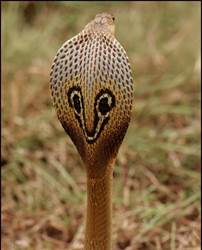 |
Common Indian Krait
- Highly venomous, neurotoxin. Known to be the second most venomous only next to the King Cobra.
- Has black body with parallel white bands
- Grows to lengths over 6 feet.
- Feeds primarily on rats and frogs.
- Active during night.
|
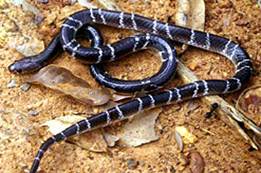 |
Russells Viper
- Highly venomous. Contains haemotoxic venom which destroys tissues and muscles.
- Grows to almost 6 feet and heavier than other snakes.
- Has the longest fangs among the common venomous snakes of the campus
- Makes an extremely loud hissing noise when threatened or alarmed.
- Easy to identify from the triangular head and the diamond shaped pattern on the body.
|
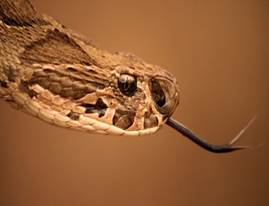
|
Saw Scaled Viper
- Highly venomous. Contains haemotoxic venom
- Easily confused with the harmless Cat Snake due to similar body pattern and size.
- Grows to only two feet and is easily missed in heavily wooded areas as it can conveniently hide underneath rocks and boulders or even leaf cover.
- Feeds mainly on rats and frogs.
- Active during dark.
|
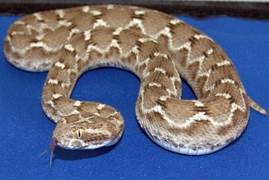
|
Common Indian Rat Snake
- most commonly found non venomous snake.
- Harmless, kills prey species only by constriction.
- Grows to lengths of over 12 feet.
- Very restless snake and can thrash around wildly when handled.
- Feeds mainly on rats and hence the name.
- Often mistaken with cobra but distinguished due to lack of hood.
|
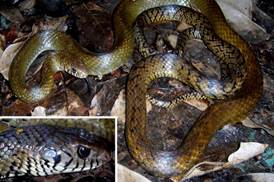
|
Common Cat Snake
- This snake is known to possess rear fangs and considered semi venomous but not potent enough to kill human beings.
- Easily mistaken with the venomous saw scaled viper but distinguished due to the presence of a Y shaped mark on the head.
- Mainly arboreal. Often found hanging down from trees.
- Feeds on rats, small lizards and birds.
|
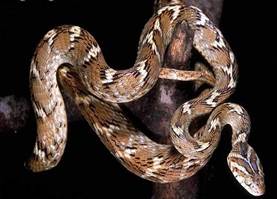
|
Green Vine Snake
- Considered s a non venomous snake,
- Possess rear fangs and is in fact semi venomous.
- The venom is not potent enough to kill human beings.
- When threatened, the snake opens its mouth to reveal the pink interiors and also expands its body to reveal the black and white scales underneath.
- This is the only snake found in Kuppam with horizontal pupils which provide the snake binocular vision.
- Grows to lengths of over 6 feet.
- Feeds mainly on lizards, frogs and small birds.
|
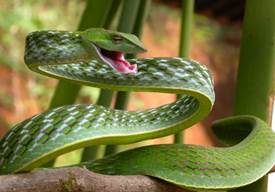
|
Common Kukri Snake
- Non venomous snake not seen very commonly.
- Grows to only little over 2 feet in length.
- Light brown back with regular black bands all across the body and an inverted V mark on the head typical of the Kukri family.
- Found mostly within termite mounds, tree holes etc.
- Feeds on small lizards, frogs and eggs of various animals.
|
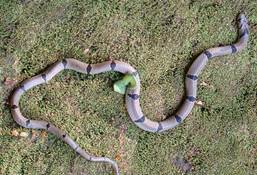
|
Common Trinket Snake
- Non venomous species of snake.
- When alarmed, raises its body and poises in a S shape ready for a quick strike and return.
- Mostly olive brown throughout with two black stripes on neck and black streaks underneath the eye.
- Often found between loose rocks.
- Feeds mainly on rats, lizards, squirrels etc.
- Grows to lengths of about 5 feet.
|
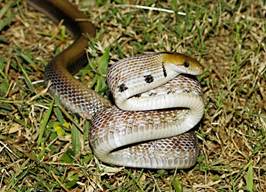
|
Checkered Keelback Snake
- A very commonly seen non venomous species.
- Seen often in monsoon within water bodies as they prefer to stay in water.
- Easily identifiable due to the checkered pattern on their body.
- Very aggressive snake and will bite repeatedly when handled.
- Feeds on fishes, crabs and frogs.
- Grows to lengths of a little over 4 feet on an average.
|
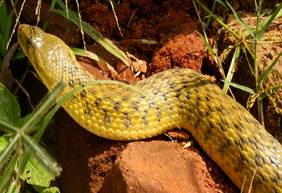
|
Lizards
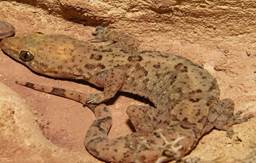 |
Brooks Gecko
- A very commonly seen gecko in dry regions.
- Just over 5 inches in length.
- Light brown throughout with dark brown spots on the body.
- Often found living under rocks, tree crevices and stones.
- Feeds mainly on small insects.
|
Termite Hill Gecko
- A very beautiful gecko found in scrub jungle habitats.
- Body light brown throughout with white edged crossbar pattern on the back.
- Found often within termite mounds and underneath rocks.
- Known to mainly feed on termites.
- Grows to about 6 inches in length.
|

|

|
Common Garden Lizard
- Found very commonly especially in south India.
- Excellent climber and often found on branches of small trees and shrubs.
- Spines on the body are typical of agamas.
- Fairly big lizard growing to almost 20 inches in length.
- Feeds mainly on insects.
|
Peninsular Rock Agama
- Brilliantly coloured agama found in dry regions.
- Males display a bright red colour during mating season.
- Tail often bigger than body in these agamas.
- They can grow up to 16 inches in length.
- Found usually underneath rocks and rubbles.
- Feeds on insects.
|

|

|
Indian Chameleon
- The most unique of all lizards
- Slow moving arboreal lizard.
- Known to have binocular vision.
- Long tongue combined with slow movement provides for the perfect weaponry to ambush prey species of insects.
- Bird like toes allow the lizard to grip branches well as they walk.
- Prehensile tail provides the additional balancing required.
|
Brahminy Skink
- Fairly commonly seen specimen on the skink family.
- Grows to about 11 inches in length.
- At first glance, looks like snake with legs.
- The upperside of the body is brown throughout with yellow lines flanking the sides. Very shiny scales on the body.
- Known to consume smaller lizards at times.
|

|

|
Snake Skink
- Very rarely seen and spends most of its time underground.
- Black upper body with fine yellow lines flanking the sides.
- In juveniles, the tail is completely red in colour.
- Grows to about 10 inches in length.
- Mainly feeds on insects.
|
Common Indian Monitor
- Biggest lizard found in Kuppam and India.
- Grows to almost 6 feet in length including tail.
- Olive coloured body throughout.
- Extremely strong claws and jaws.
- Mainly carnivores and hunts small mammals and birds.
- Extremely fast runner and very good climber.
- Found in burrows made by other animals
|

|
Terrapins
 |
Indian Pond Terrapin
- Most commonly found terrapin in water bodies all across.
- Grows to almost a foot in length.
- Very easy to identify mainly due to its black shell and webbed feet.
- Feeds mainly on vegetable matter.
- Can be found both inside water bodies or basking on rocks.
|
Indian Flap Shell
- Quite commonly seen in water bodies around dry areas.
- Easily distinguishable due to its smooth olive coloured shell, webbed feet and a very elongated neck with extended nostrils.
- Species is an omnivore feeding on water plants and small animals such as crabs, fishes etc. found within water.
- A bulky terrapin, a fully grown adult can weigh more than 5 kilograms.
- Known to travel long distances on land in search of water during dry months.
|

|
| |

























